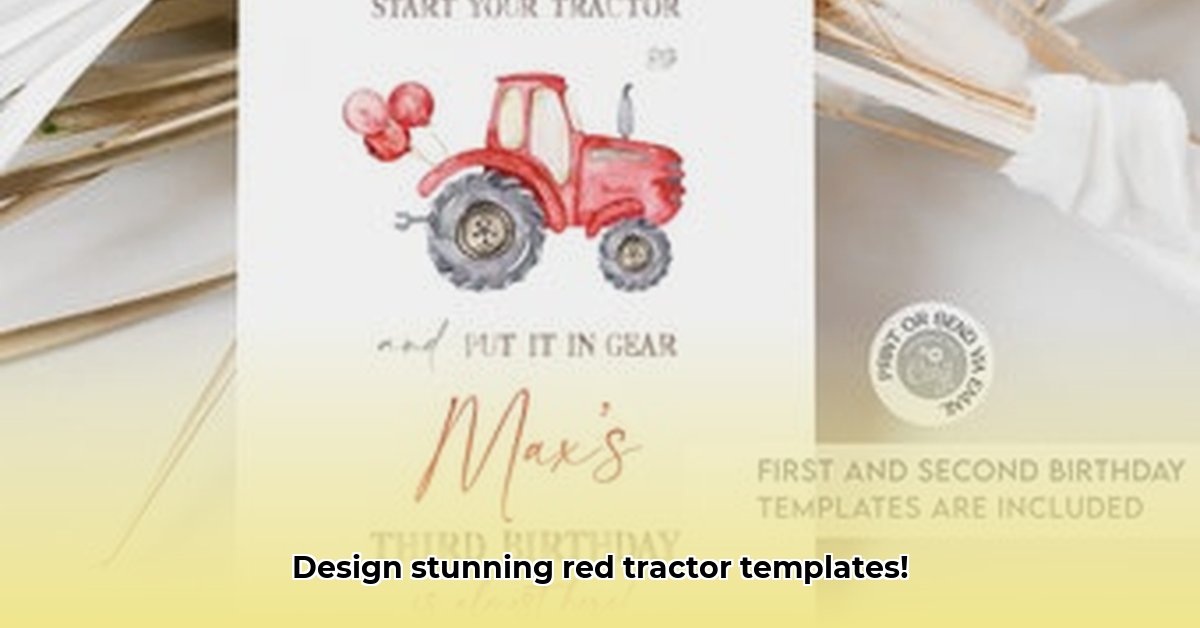
This comprehensive guide will walk you through creating captivating red tractor templates, regardless of your design experience. We'll cover everything from choosing the right software to adding realistic details, ensuring your designs are both stunning and effective.
Choosing Your Design Software: The Right Tools for the Job
The first step involves selecting appropriate design software. Several excellent options cater to different skill levels and aesthetic goals. For sharp, vector-based designs that scale perfectly without quality loss, Adobe Illustrator is a professional favorite (though it has a steeper learning curve). If you prefer photorealistic results with textures and detailed effects, Adobe Photoshop excels at capturing lifelike qualities such as dirt and wear.
However, access to professional software isn't a requirement! Free alternatives like GIMP (similar to Photoshop) and Inkscape (similar to Illustrator) provide powerful capabilities for budget-conscious designers. The key is to choose a program that matches your skill level and budget; the most important thing is to begin! Have you considered which software best suits your needs and budget?
Sketching Your Masterpiece: Planning Your Red Tractor Design
Before diving into digital design, grab a pencil and paper. Sketching your ideas allows you to brainstorm various details: robust tires, bright headlights, perhaps even a friendly farmer at the wheel! What atmosphere do you want your tractor to evoke—a rugged, vintage workhorse or a sleek, modern machine? Your sketch acts as your design blueprint. Don't strive for perfection; simply capture your initial concepts.
Designing Your Red Tractor: A Step-by-Step Illustrator Tutorial (Adaptable to Other Software)
Let's create your red tractor! This tutorial primarily utilizes Illustrator, but the principles apply to most design software.
Step 1: Setting Up Your Canvas: Create a new document in your chosen software. Determine the desired dimensions. Will this design become a postcard, sticker, or large-scale mural? The document size depends entirely on your project's intended application.
Step 2: Constructing the Tractor's Body: Utilize fundamental shapes—rectangles, circles, and possibly trapezoids—to build the tractor's main body. Begin with the chassis, then add the wheels. You can later refine and combine these shapes for a perfect fit. Don't worry about precise perfection at this stage.
Step 3: Adding the Details: Now for the fun part! Use smaller shapes to create headlights, an exhaust pipe, even a tiny steering wheel. Let your creativity flow! Your initial sketch will prove invaluable here.
Step 4: Applying the Red Hue: Time to paint! Fill your shapes with vibrant shades of red. Experiment with different red tones to add depth. A darker red in shadowed areas enhances realism.
Step 5: Polishing and Refining: This step refines your design. Adjust shapes for smoothness, add shadows, and implement subtle highlights to create a 3D effect. Attention to detail is crucial for a polished final product. Take your time!
Step 6: Saving Your Creation: Once satisfied with your design, save it in the appropriate file format. PNG is versatile, JPG is ideal for photos, and SVG offers scalable quality.
Boosting Realism with Photoshop (Optional)
For ultra-realistic results, Photoshop offers powerful capabilities.
Step 1: Importing Your Design: Begin by importing your Illustrator file (or the file from your chosen software) into Photoshop. This serves as your base.
Step 2: Applying Texture and Depth: Photoshop enables you to add textures for simulating metal, rust, or dirt. Subtle scratches can enhance a weathered look, suggesting the tractor's history.
Step 3: Manipulating Lighting and Shadows: Experiment with lighting to create a three-dimensional effect. Adding highlights and shadows dramatically affects visual depth.
Step 4: Adding the Finishing Touches: Utilize Photoshop's brushes for fine details, like tiny rivets. You can even create custom brushes for greater control.
Designing for Different Projects: Adapting Your Template
The design must align with the project’s purpose. Here are some considerations:
| Use Case | Design Considerations |
|---|---|
| T-shirt Print | Simple design, bold colors, and scalability are key. |
| Business Card | Minimalist design, professional font, clear contact info. |
| Website Banner | Eye-catching, high-resolution, and optimized file size. |
Remember, consistent practice improves skill. Experiment fearlessly, and seek inspiration from online red tractor designs. Above all, let your creativity shine!